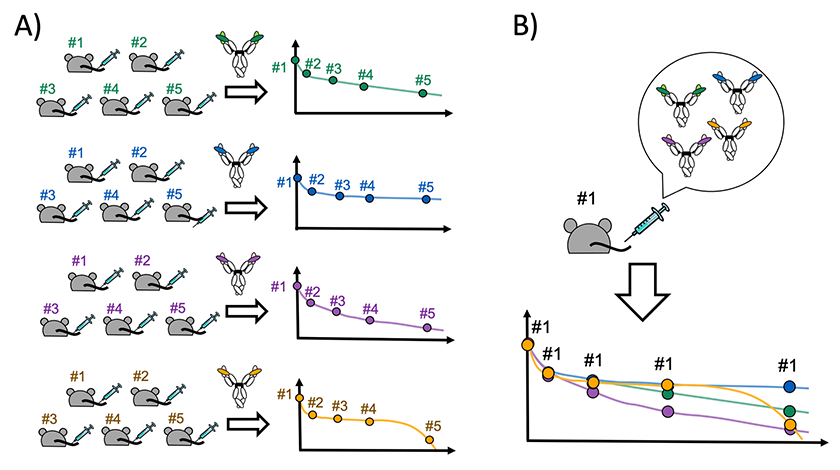動物を用いた研究
中外製薬では「革新的な医薬品とサービスの提供を通じて新しい価値を創造し、世界の医療と人々の健康に貢献する」ことを企業理念に掲げ、革新的な医薬品の開発を進めています。
医薬品の開発に際して、ヒトでの臨床試験を行い有効性・安全性を確認する必要がありますが、世界の規制当局は臨床試験を進める前に動物による研究から得られた有効性・安全性データを要求しています。また、現在の科学レベルでは、ヒトや動物の生体反応を生体を用いずに模倣することは不可能であり、有効かつ安全な医薬品提供のためには動物による研究が必要です。
中外製薬では、動物を取り扱う際には、以下の3Rの原則を満たすように努めています。
Replacement(動物の代替)
動物を用いない、代替的な実験方法への置換え
医薬品候補化合物の選択において、腸管オルガノイドなどヒト由来細胞を用いた実験モデルやコンピュータ上でのシミュレーションなど、動物を使用しない方法を取り入れ*1 *2 *3、薬物動態、有効性、安全性を評価しています。
Reduction(動物数の削減)
使用する動物数を必要最小限となるように削減
複数の開発候補品を混合して動物に投与することにより、これまで個々の候補品ごとに行っていた薬物動態試験での動物使用数を大幅に削減*4 *5しています。

Figure Schematic illustration of animal usage reduction by cassette-dosing and microsampling
(A) For single-dosing PK of each mAbs using one sample per animal, 60 mice are required to evaluate four mAbs at n=3/group and six time sampling points. (B) For cassette-dosing, the PK of a mixture of four mAbs by microsampling, four mice are required to evaluate four mAbs at n=3/group and six time sampling points.
Refinement(苦痛の軽減)
可能な限り動物に苦痛を与えない配慮*6 *7
動物に対してより快適な飼育環境を提供するため、玩具や巣材の使用、獣医学的ケアの継続的向上を推進しています。
中外製薬では動物の管理および使用に関する国内の法令やガイドラインを遵守するとともに、実験動物委員会(IACUC)を設置し、3Rの原則の遵守状況の確認・評価・監視、実験計画書の審査および承認、動物の管理および使用に従事する担当者への教育訓練を行っています。
このような当社の取り組みが、世界的な第三者評価機関である国際実験動物ケア評価認証協会(AAALAC International)により評価され、2007年以降継続して認証を取得しており、今後も認証取得を維持していきます。
3Rsに貢献した研究論文
- *1 Noguchi Y., Ozeki K., Akita H., Pharmacokinetic prediction of an antibody in mice based on an in vitro cell-based approach using target receptor-expressing cells. Sci Rep. 2020 Oct 1;10(1):16268. doi: 10.1038/s41598-020-73255-1.
- *2 Noguchi Y., Ozeki K., Takesue H., Akita H., A cell based assay for evaluating binding and uptake of an antibody using hepatic nonparenchymal cells. Sci Rep. 2021 Apr 16;11(1):8383. doi: 10.1038/s41598-021-87912-6.
- *3 Tanaka K., Mochizuki T., Baba S., Kawai S., Nakano K., Tachibana T., Uchimura K., Kato A., Miyayama T., Yamaguchi T., Nishihara H., Terao K., Kato Y., Robust and reproducible human intestinal organoid-derived monolayer model for analyzing drug absorption. Sci Rep. 2025 Apr 3;15(1):11403. doi: 10.1038/s41598-025-95823-z.
- *4 Nagayasu M. and Ozeki K., Combination of cassette-dosing and microsampling for reduced animal usage for antibody pharmacokinetics in cynomolgus monkeys, wild-type mice, and human FcRn transgenic mice. Pharm Res. 2021 Apr;38(4):583-592. doi: 10.1007/s11095-021-03028-6.
- *5 Nagayasu M., Takano Y., Ozeki K., Development of a New Method to Evaluate the Biodistribution of Antibodies Using Non-Radioactive Metal Labeling and Inductively Coupled Plasma Mass Spectrometry. Pharm Res. 2023 Jul;40(7):1807-1819. doi: 10.1007/s11095-023-03541-w.
- *6 Ko T., Nishiwaki K., Terada K., Tanaka Y., Mitsumata S., Katagiri R., Taketo J., Horiba N., Igata H., Mizuno K., Development of a Stereo-Vision Based High-Throughput Robotic System for Mouse Tail Vein Injection. ICRA. 2022 doi.org/10.48550/arXiv.2205.12756.
- *7 Miyagi D., Nakano H., Watanabe T., Isobe T., Evaluation of the Tunnel Handling Method: Time Required for Skill Acquisition and Cage Changing. Journal of Experimental Animal Technology. 2025 In Press.
